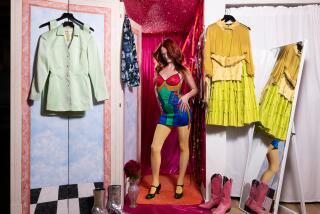Russian Designers Jump Into the Jeans Pool
- Share via
MOSCOW — Cashing in on the insatiable craze for the West’s signature fashion item--blue jeans--two of Russia’s top designers are now muscling into this market and burying the Communist legacy that denounced denim as an emblem of decadence.
Haute couture designers Valentin Yudashkin and Alexei Grekoff are carving out a national niche in the jeans market this fall by adapting the West’s wardrobe standby to the tastes and trends prevailing in their country.
One of those themes guiding consumers through the unfamiliar worlds of choice and plenty is a government appeal to “buy Russian”--a timely campaign that could help the native newcomers rise above the more established names of Levi’s, Wrangler and Calvin Klein.
“Buying Russian jeans fits well with today’s national idea,” says Grekoff spokeswoman Irina Guseva, referring to a push by President Boris N. Yeltsin’s economic gurus for patriotic consumerism. In the Soviet era, wearing jeans was often regarded as an anti-government statement.
Still, jeans can only differ so much from one culture to another, says Guseva, explaining why the imagery surrounding their collection is so important. “We provide an alternative to the American variant--the Russian answer to the Marlboro myth.”
*
Grekoff’s “New Denim Philosophy,” as the line is called, features denim jackets for women that are tapered to show curves and pants that do the same, unlike his straighter cuts for men. The designer says his women’s line is “for the aristocratic lady”--who is being reinvented after seven decades of social leveling in the Soviet Union.
The male ideal Grekoff wants to project is unabashedly macho. “Crime is a problem in Russia today and it is important for men to be strong and capable protectors,” says the designer, pointing to the chiseled male images who run across the pages of his catalog.
Vying with other mid-range brands like Levi’s, Lee, Wrangler and Pierre Cardin, Grekoff jeans sell for about $70 in more than 50 stores across Russia. Yudashkin jeans will cost more than $100 when they hit stores this October, placing them in a price category with designers like Versace, Dolce & Gabbana, Trussardi and Calvin Klein.
Yudashkin unveiled his 250-item “Jeans Revolution” collection in June, offering everything from side-zipped shorts to ball gowns.
Since the first jeans were smuggled into the Soviet Union in the late-1950s, they have undergone a transition from political statement to fashion statement. Today, the average urban-dwelling Russian owns two to three pairs, reports Interpromsystema, official distributor of Diesel jeans.
But both the denim-designing debutantes of Russia and the established purveyors of the West consider the market far from sated. Levi’s, which opened its first Russian store in February 1993, plans to expand beyond its current 31 outlets, unafraid of competition from the new Russian lines.
“Levi’s makes jeans, these designers make pants out of denim,” boasts Levi’s marketing manager Andrei Rugachev, arguing that the Russians and the Westerners aren’t after the same customer.
*
Flipping through the piles of jeans at Pyramid 2000 in search of a new pair for winter, Tatyana Kovalyova, 30, a financial analyst, says she is inclined to buy Grekoff but puts off a final decision with the once-alien excuse that this time she is “just looking.”
Prices for designer brands are beyond the reach of many Russians whose average salary is only $200 a month. “Counterfeit jeans account for about 70% of what you see people wearing,” estimates Sergei Mishin, who sells 20 to 30 pairs of jeans daily from his stall at a Moscow clothing market. Most are produced in Turkey, Poland and Southeast Asia, but according to Mishin, quality counterfeits increasingly are being made in Moscow, too.
Demand for knock-off jeans at the crude outdoor clothing markets where many working-class Russians shop may provide the best indicator of the popularity of the styles being offered by Yudashkin and Grekoff.
“If people like them and start asking for them, somebody will start reproducing them,” says Mishin.
Russian consumers who can afford the luxury examine their clothing’s country of origin as closely as the brand name. “Russians place a ridiculous amount of importance on the location of production,” says Levi’s Rugachev.
*
Last year, 82% of the clothing purchased in Russia was produced abroad, according to the State Statistics Committee. Included in this figure are the jeans made from Yudashkin and Grekoff designs, stretching the credibility of their marketers’ appeal to “buy Russian.” Yudashkin’s production facilities are located in Spain and Grekoff’s are in Italy.
Aside from the challenge of breaking into a market long dominated by Western labels, Russian designers are also hampered by the stigma attached to Soviet-era productions. State-run factories here started making jeans as early as 1975 but the quality was inferior to those smuggled in by the few who could travel abroad in that era.
Unlike today, getting a pair of jeans during the Soviet era was never as simple as walking into a store and buying them. “My first pair was a pair of women’s Lee’s that I bought from a friend whose husband was a pilot for Aeroflot. I couldn’t afford to buy them on the black market,” recalls Natasha Rybkina, 48, who paid the equivalent of two months of her student stipend for the 1972 purchase. “It was considered prestigious to own them since not everyone could. Now everyone wears them.”






